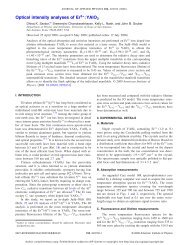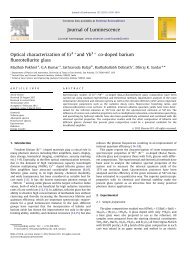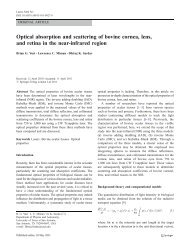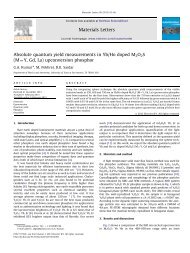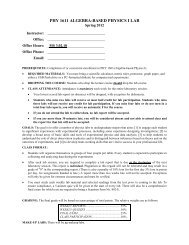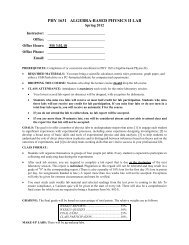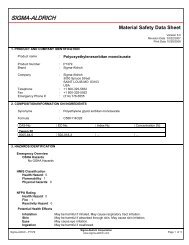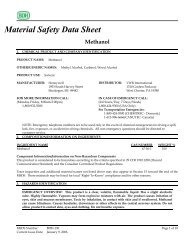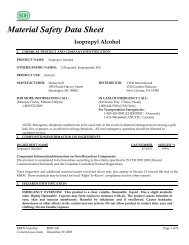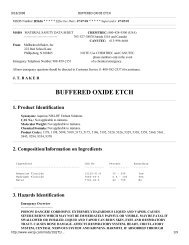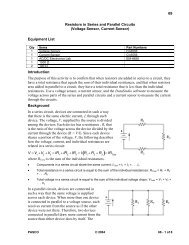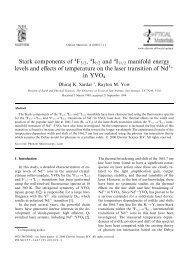Titanium pellets
Titanium pellets
Titanium pellets
You also want an ePaper? Increase the reach of your titles
YUMPU automatically turns print PDFs into web optimized ePapers that Google loves.
ERAC Online Catalog Search http://asp.cerac.com/CatalogNet/default.aspx?p=msdsFi...<br />
SUPPLIER<br />
M A T E R I A L S A F E T Y D A T A S H E E T<br />
GENERATED 09/16/2008, REVISION 11/12/2007, SUPERCEDES REVISION 12/15/2004, DATE<br />
CREATED 10/25/1992<br />
SECTION 1. PRODUCT AND COMPANY IDENTIFICATION<br />
<strong>Titanium</strong> metal, powder and pieces (>75 microns)<br />
PRODUCT CODE: T-MSDS0037<br />
PRODUCT NAME: <strong>Titanium</strong> metal, powder and pieces (>75 microns)<br />
REFERENCE #:<br />
MANUFACTURER INFORMATION<br />
7440-32-6<br />
COMPANY NAME: CERAC, inc.<br />
EMERGENCY CONTACT: CHEMTREC (800)424-9300<br />
ALTERNATE EMERGENCY<br />
CONTACT:<br />
CERAC, inc. (414)289-9800<br />
CHEMICAL FAMILY: Metal<br />
CAS NUMBER: 7440-32-6<br />
RTECS #: XR1700000<br />
UPC/EAN:<br />
SYNONYMS<br />
231-142-3<br />
<strong>Titanium</strong> metal; contimet 30; C.P. titanium; IMI 115; NCI-CO4251; oremet; titanium alloy.<br />
Hazardous Components<br />
(Chemical Name)<br />
SECTION 2. COMPOSITION/INFORMATION ON INGREDIENTS<br />
<strong>Titanium</strong> metal, powder and pieces (>75 microns)<br />
CAS # Concentration OSHA<br />
PEL<br />
ACGIH<br />
TLV<br />
<strong>Titanium</strong> 7440-32-6 0.0 -100.0 % NE NE NE<br />
See SECTION 16-Other Information NA 0.0 -100.0 % No data. No data. No data.<br />
SECTION 3. HAZARDS IDENTIFICATION<br />
<strong>Titanium</strong> metal, powder and pieces (>75 microns)<br />
EMERGENCY OVERVIEW<br />
THIS MATERIAL IS CONSIDERED TO BE PHYSIOLOGICALLY INERT.<br />
ROUTE(S) OF ENTRY: Inhalation? Yes , Skin? No , Eyes? No , Ingestion? No Other: N<br />
POTENTIAL HEALTH EFFECTS (ACUTE AND CHRONIC)<br />
Other<br />
Limits<br />
TITANIUM: This material is generally considered to be physiologically inert. There are no reported cases in<br />
the literature where titanium as such has caused human intoxication. The dusts of titanium or most<br />
titanium compounds such as titanium oxide may be placed in the nuisance category. (Sax, Dangerous<br />
Properties of Industrial Materials, eighth edition)<br />
INHALATION:<br />
Acute: Prolonged inhalation may cause mild irritation to the lungs and respiratory tract.<br />
Chronic: May cause fibrotic lung changes.<br />
1 of 6 10/28/2008 9:17 AM
ERAC Online Catalog Search http://asp.cerac.com/CatalogNet/default.aspx?p=msdsFi...<br />
INGESTION:<br />
Acute: Relatively non-toxic, poorly absorbed from the ailmentary tract.<br />
Chronic: No chronic health effects recorded.<br />
SKIN: Acute: May cause abbrasive irritation.<br />
Chronic: No chronic health effects recorded.<br />
EYE:<br />
Acute: May cause abbrasive irritation.<br />
Chronic: No chronic health effects recorded.<br />
TARGET ORGANS: No target organs recorded.<br />
RECOMMENDED EXPOSURE LIMITS<br />
See "Section II"<br />
LD 50 / LC 50<br />
See "Carcinogenicity/Other Information"<br />
SIGNS AND SYMPTOMS OF EXPOSURE<br />
INHALATION: Prolonged exposure may cause a red, dry, throat, coughing and shortness of breath.<br />
INGESTION: No acute or chronic health effects recorded.<br />
SKIN: May cause redness and itching.<br />
EYE: May cause redness, itching and watering.<br />
MEDICAL CONDITIONS GENERALLY AGGRAVATED BY EXPOSURE<br />
None recorded.<br />
SECTION 4. FIRST AID MEASURES<br />
<strong>Titanium</strong> metal, powder and pieces (>75 microns)<br />
EMERGENCY AND FIRST AID PROCEDURES<br />
INHALATION: Remove victim to fresh air; keep warm and quiet; give oxygen if breathing is difficult and seek<br />
medical attention if symptoms persist.<br />
INGESTION: Give 1-2 glasses of milk or water and induce vomiting; Never induce vomiting or give anything<br />
by mouth to an unconscious person.<br />
SKIN: Remove contaminated clothing; brush material off skin; wash affected area with mild soap and water;<br />
seek medical attention if symptoms persist.<br />
EYE: Flush eyes with lukewarm water, lifting upper and lower eyelids, for at least 15 minutes. Seek medical<br />
attention if symptoms persist.<br />
SECTION 5. FIRE FIGHTING MEASURES<br />
<strong>Titanium</strong> metal, powder and pieces (>75 microns)<br />
FLASH PT: N.A.<br />
EXPLOSIVE LIMITS: LEL: NA UEL: NA<br />
AUTOIGNITION PT: 1200.00 C (2192.0 F)<br />
FIRE FIGHTING INSTRUCTIONS<br />
Firefighters must wear full face, self-contained breathing apparatus with full protective clothing to prevent<br />
contact with skin and eyes. Fumes from fire are hazardous. Isolate runoff to prevent environmental pollution.<br />
2 of 6 10/28/2008 9:17 AM
CERAC Online Catalog Search http://asp.cerac.com/CatalogNet/default.aspx?p=msdsFi...<br />
FLAMMABLE PROPERTIES AND HAZARDS<br />
May burn in an atmosphere of carbon dioxide, nitrogen or air.<br />
May react violently with BrF3; CuO; PbO; (Ni + KClO3), metaloxy salts; halocarbons; halogens; CO2 metal<br />
carbonates; Al; AgF; O2; nitryl fluoride; HNO3; O2; KClO3; KNO3; KMnO4; steam at 704F; trichloroethylene;<br />
trichlorotri-fluoroethane. <strong>Titanium</strong>, in the absence of moisture, burns slowely, but evolves much heat.<br />
Water applied to hot titanium may evolve hydrogen, causing an explosion.<br />
EXTINGUISHING MEDIA<br />
AUTOIGNITION POINT: 1200C for solid metal in air<br />
250C for powder in air<br />
USE: Class D, inert gas (argon or helium) or other metal extinguishing agent.<br />
DO NOT USE: Water or carbon dioxide. Water applied to hot titanium may evolve hydrogen, causing an<br />
explosion.<br />
UNSUITABLE EXTINGUISHING MEDIA<br />
No data available.<br />
SECTION 6. ACCIDENTAL RELEASE MEASURES<br />
<strong>Titanium</strong> metal, powder and pieces (>75 microns)<br />
STEPS TO BE TAKEN IN CASE MATERIAL IS RELEASED OR SPILLED<br />
Wear appropriate respiratory and protective equipment specified in section VIII-control measures. Isolate<br />
spill area and provide ventilation. Vacuum up spill using a high efficiency particulate absolute (HEPA) air<br />
filter and place in a closed container for proper disposal. Take care not to raise dust.<br />
SECTION 7. HANDLING AND STORAGE<br />
<strong>Titanium</strong> metal, powder and pieces (>75 microns)<br />
HAZARD LABEL INFORMATION:<br />
Store in cool, dry area Store in tightly sealed container Wash thoroughly after handling<br />
PRECAUTIONS TO BE TAKEN IN HANDLING<br />
Do not disperse powder or dust in air.<br />
PRECAUTIONS TO BE TAKEN IN STORING<br />
None<br />
OTHER PRECAUTIONS<br />
None<br />
SECTION 8. EXPOSURE CONTROLS/PERSONAL PROTECTION<br />
<strong>Titanium</strong> metal, powder and pieces (>75 microns)<br />
PROTECTIVE EQUIPMENT SUMMARY - HAZARD LABEL INFORMATION:<br />
NIOSH approved respirator Impervious gloves Safety glasses<br />
RESPIRATORY EQUIPMENT (SPECIFY TYPE)<br />
NIOSH approved respirator<br />
EYE PROTECTION<br />
Safety glasses<br />
PROTECTIVE GLOVES<br />
Rubber gloves<br />
OTHER PROTECTIVE CLOTHING<br />
Protective gear suitable to prevent contamination<br />
ENGINEERING CONTROLS (VENTILATION ETC.)<br />
3 of 6 10/28/2008 9:17 AM
CERAC Online Catalog Search http://asp.cerac.com/CatalogNet/default.aspx?p=msdsFi...<br />
Use process enclosures, local exhaust ventilation, or other engineering controls to control airborne levels.<br />
Powders under 74 microns are flammable.<br />
WORK/HYGIENIC/MAINTENANCE PRACTICES<br />
Implement engineering and work practice controls to reduce and maintain concentration of exposure at low<br />
levels. Use good housekeeping and sanitation practices. Do not use tobacco or food in work area. Wash<br />
thoroughly before eating and smoking. Do not blow dust off clothing or skin with compressed air.<br />
SECTION 9. PHYSICAL AND CHEMICAL PROPERTIES<br />
<strong>Titanium</strong> metal, powder and pieces (>75 microns)<br />
PHYSICAL STATES: [ ] Gas [ ] Liquid [ X ] Solid<br />
MELTING POINT: 1650.00 C (3002.0 F) - 1670.00 C (3038.0 F)<br />
BOILING POINT: 3287.00 C (5948.6 F)<br />
AUTOIGNITION PT: 1200.00 C (2192.0 F)<br />
FLASH PT: N.A.<br />
EXPLOSIVE LIMITS: LEL: NA UEL: NA<br />
SPECIFIC GRAVITY (WATER = 1): 4.5 at 20.0 C (68.0 F)<br />
VAPOR PRESSURE (VS. AIR OR<br />
MM HG):<br />
0 at 20.0 C (68.0 F)<br />
VAPOR DENSITY (VS. AIR = 1): No data.<br />
EVAPORATION RATE (VS BUTYL<br />
ACETATE=1):<br />
No data.<br />
SOLUBILITY IN WATER:<br />
SOLUBILITY NOTES<br />
decomposes steam at 700-800C<br />
insoluble<br />
PERCENT VOLATILE: N.A.<br />
CORROSION RATE: No data.<br />
FORMULA: Ti<br />
MOLECULAR WEIGHT: 47.88<br />
PH:<br />
APPEARANCE AND ODOR<br />
No data.<br />
Dark gray powder or silver-gray pieces, no odor.<br />
SECTION 10. STABILITY AND REACTIVITY<br />
<strong>Titanium</strong> metal, powder and pieces (>75 microns)<br />
STABILITY: Unstable [ ] Stable [ X ]<br />
CONDITIONS TO AVOID - INSTABILITY<br />
Dispersion in air<br />
INCOMPATIBILITY - MATERIALS TO AVOID<br />
TITANIUM: Air, BrF3, CuO, PbO, (Ni + KClO3), metaloxy salts, halocarbons, halogens. CO2, metal carbonates,<br />
Al, AgF, O2 nitryl fluoride, HNO3, KClO3, KNO3, KMnO4, steam (>700C), trichloroethylene, trichlorotrifluoroethane,<br />
oxygen, carbon black, carbon dioxide and nitrogen, sodium chlorate.<br />
Water applied to hot titanium may evolve hydrogen, causing an explosion.<br />
HAZARDOUS DECOMPOSITION OR BYPRODUCTS<br />
4 of 6 10/28/2008 9:17 AM
CERAC Online Catalog Search http://asp.cerac.com/CatalogNet/default.aspx?p=msdsFi...<br />
Metal fumes and titanium oxides<br />
HAZARDOUS POLYMERIZATION: Will occur [ ] Will not occur [ X ]<br />
CONDITIONS TO AVOID - HAZARDOUS POLYMERIZATION<br />
None<br />
SECTION 11. TOXICOLOGICAL INFORMATION<br />
<strong>Titanium</strong> metal, powder and pieces (>75 microns)<br />
ims-rat TDLo: 114 mg/kg/77W-I:ETA<br />
CARCINOGENICITY/OTHER INFORMATION<br />
Questionable carcinogen with experimental tumorigenic data. Experimental reproductive effects.<br />
orl-rat TDLO: 158 mg/kg multi:Reproductive effects<br />
Intramuscular-rat TDLO: 114 mg/kg/77W-I: Equivocal Tumorigenic Agent<br />
Intramuscular-rat TD: 360 mg/kg/69W-I: Equivocal Tumorigenic Agent<br />
CARCINOGENICITY: NTP? No IARC Monographs? No OSHA Regulated? No<br />
Ecotoxicity: Not Established<br />
SECTION 12. ECOLOGICAL INFORMATION<br />
<strong>Titanium</strong> metal, powder and pieces (>75 microns)<br />
SECTION 13. DISPOSAL CONSIDERATIONS<br />
<strong>Titanium</strong> metal, powder and pieces (>75 microns)<br />
WASTE DISPOSAL METHOD<br />
Dispose of in accordance with local, state and federal regulations.<br />
SECTION 14. TRANSPORT INFORMATION<br />
<strong>Titanium</strong> metal, powder and pieces (>75 microns)<br />
LAND TRANSPORT (US DOT)<br />
DOT PROPER SHIPPING NAME <strong>Titanium</strong> Metal Powder Dry<br />
UN/NA NUMBER: UN2546<br />
US EPA SARA TITLE III<br />
Hazardous Components (Chemical<br />
Name)<br />
SECTION 15. REGULATORY INFORMATION<br />
<strong>Titanium</strong> metal, powder and pieces (>75 microns)<br />
CAS #<br />
Sec.302<br />
(EHS)<br />
Sec.304<br />
RQ<br />
<strong>Titanium</strong> 7440-32-6 No No No<br />
See SECTION 16-Other Information<br />
SARA (SUPERFUND<br />
AMENDMENTS AND<br />
REAUTHORIZATION ACT OF<br />
NA No No No<br />
Sec.313<br />
(TRI)<br />
5 of 6 10/28/2008 9:17 AM
CERAC Online Catalog Search http://asp.cerac.com/CatalogNet/default.aspx?p=msdsFi...<br />
1986) LISTS:<br />
SEC.302: EPA SARA Title III Section 302 Extremely Hazardous Chemical with TPQ.<br />
* indicates 10000 LB TPQ if not volatile.<br />
SEC.304: EPA SARA Title III Section 304: CERCLA Reportable + Sec.302 with<br />
Reportable Quantity. ** indicates statutory RQ.<br />
SEC.313: EPA SARA Title III Section 313 Toxic Release Inventory. Note: -Cat<br />
indicates a member of a chemical category.<br />
SEC.110: EPA SARA 110 Superfund Site Priority Contaminant List<br />
SECTION 16. OTHER INFORMATION<br />
<strong>Titanium</strong> metal, powder and pieces (>75 microns)<br />
Control of Substances Hazardous to Health Regulations<br />
EH40 Occupational Exposure Limits<br />
Maximum Exposure Limit: NE<br />
Occupational Exposure Standard: NE<br />
.<br />
COMPANY POLICY OR DISCLAIMER<br />
The above information is accurate to the best of our knowledge. However, since data, safety standards, and<br />
government regulations are subject to change, and the conditions of handling and use or misuse are beyond<br />
our control, CERAC MAKES NO WARRANTY, EITHER EXPRESSED NOR IMPLIED, WITH RESPECT TO THE<br />
COMPLETENESS OR CONTINUING ACCURACY OF THE INFORMATION CONTAINED HEREIN, AND<br />
DISCLAIMS ALL LIABILITY FOR RELIANCE THEREON. Users should satisfy themselves that they have all<br />
current data relevant to their particular use.<br />
Abbreviations used: NA=Not Applicable NE: Not Established<br />
Health: 1<br />
OTHER HAZARD RATINGS:<br />
Health: 1<br />
Flammability: 0 Flammability: 0<br />
Reactivity: 0 Reactivity: 0<br />
Protection: E<br />
Special Hazard: E<br />
Minimal: 0<br />
Slight: 1<br />
Moderate: 2<br />
Serious: 3<br />
Extreme: 4<br />
GENERATED 09/16/2008<br />
REVISION 11/12/2007<br />
SUPERCEDES REVISION 12/15/2004<br />
DATE CREATED 10/25/1992<br />
6 of 6 10/28/2008 9:17 AM




